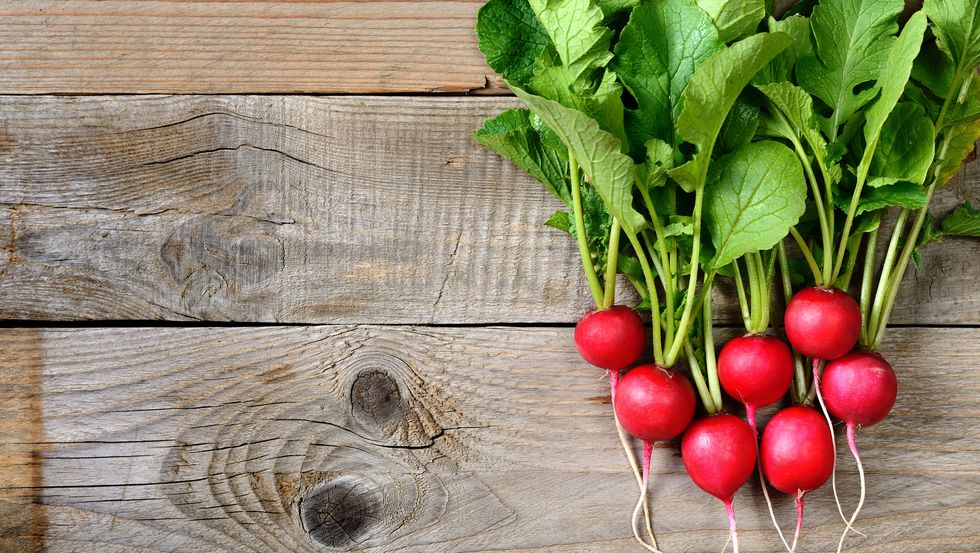There are two kinds of foods: the ones that you actually eat, and the ones that are used as garnish. (Really. Who eats that sprig of parsley that comes with every restaurant omelette?)
On that list of after-thought foods: radishes. What are radishes good for, anyways?
Nutrition-wise, radishes are actually pretty awesome, says Katie Simmons, a plant-based personal chef in Chicago. “This spring-to-summer staple is a great source of vitamin C,” she says—about 22 percent of your daily value in each cup of sliced radishes, according to the USDA. The super-low calorie veggie (literally 1 calorie per radish) also adds a surprising, peppery, spicy crunch to your food.
Skeptical? Here’s the low-down on the spring vegetable:
What to do with radishes:
Different radishes are best prepared in their own unique ways, says Simmons. Here’s what to do with five of the most common types of radishes:
Cherry Belle Radishes
This little, round red radish is the most common you’ll find in most supermarkets. Slice it thin and add it to salads, tacos, sandwiches, or burgers for a peppery crunch. Serve as radish chips to accompany hummus, olive tapenade, or fava bean dip. Or layer on top of avocado toast made with hearty whole-grain bread and mashed avocados with lemon juice.
French Breakfast Radishes
These longer oval pink-to-white radishes are mild and crunchy. Simmons recommends roasting them, then adding whole to side salads or eating as a light snack. To roast, toss radishes in salt, pepper, and olive oil and heat in the oven for 10 to 15 minutes at 425 F.
Daikon (Chinese) Radishes
“This is a good intro to radishes if you don’t want something too spicy,” says Simmons of this long, white radish. “Plus because of the shape, it’s easy to cut,” she says. The daikon radish cooks up well in broths and soups (red radishes tend to turn things red), or works thinly sliced in cabbage slaw.
Black Spanish Radishes
Because they’re super spicy, black radishes are best pickled to cut the kick, says Simmons. Toss about 40 to 50 washed radishes in a large pot. Add one and a half cups water, one tablespoon white vinegar, two tablespoons of honey or maple syrup, two tablespoons olive oil, and a dash of salt and pepper. Bring to a boil and simmer for 10 to 15 minutes, until radishes are nicely cooked and glazed. Use over salads or on foods like tacos and chili for a sweet and spicy kick.
Easter Egg Radishes
These round radishes come in a rainbow of colors: pink, red, scarlet, and gold. Simmons likes to pair with other spring vegetables to highlight their colors. Slice and toss a half cup sliced radish with two cups steamed snap peas, two teaspoons rice vinegar, half a teaspoon toasted sesame seeds, and one teaspoon maple syrup for a light, healthy salad.
Okay, so how do I pick the freshest radishes?
Whenever possible, opt for radishes with the greens attached; the leaves should look healthy and fresh, which tells you it hasn’t been sitting on the shelf for too long. The radishes themselves should look firm and bright, with no wrinkles, mold, or mildew.
How to store radishes
Take radishes out of their plastic produce bag and store in a cool, dry, well-ventilated place (like your refrigerator veggie bin), says Simmons. Keep the top inch or so of the greens attached so it stays fresh for a bit longer.
Radishes should store for quite a while, like carrots or potatoes—two to three weeks. If you’ve pre-sliced radishes to use later on, keep them in water in your fridge so they stay crisp and retain their color.
How to cut and prep radishes
Many radishes are small and round, plus you’re often slicing them thin—making them especially tricky to prep. Simmons recommends investing in a Japanese-style mandolin, which you can find online for under $50. You don’t need to peel. Just use a veggie scrubber to take off the dirt and grit, then trim the ends and slice. For longer radishes or larger chunks, use a paring knife instead.












